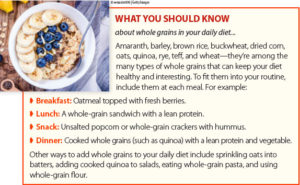Use Whole Grains to Rein in High Blood Sugar and Diabetes
You may not think about the health benefits of whole grains as you munch popcorn, dig into hot oatmeal, or take a bite of a rye sandwich. But whole grains are among the powerhouses of a diet that can help us ward off high blood sugar and diabetes. “Whole grains should be eaten at every meal,” says Gabrielle Gambino, a registered dietitian nutritionist with Weill Cornell Medicine.
What’s Their Superpower?
Whole grains are seeds or kernels that contain three parts: the (the outer layer rich in fiber and antioxidants), (a tiny embryo rich in vitamins and minerals), and (a food supply for the embryo rich in carbohydrates and some proteins).
The nutritional wallop of whole grains helps protect against chronic disease. And the bran and fiber in whole grains makes them burn slowly, giving your cells time to absorb their nutrients and energy.

Refined grains, on the other hand—which are stripped of the bran and germ—are digested quickly, flooding the bloodstream as glucose (blood sugar). “When there’s a large spike in blood sugar, it stays in the bloodstream longer, and that has a big impact on your organs and increases inflammation in the body,” says Gambino.
It’s no wonder, then, that eating whole grains regularly is associated with lowering blood sugar and reducing the risk for developing type 2 diabetes.
Even More Benefits
Because whole grains are digested slowly, they help you feel full longer. “The slower a food moves through the gastrointenstinal tract, the longer it takes for you to start feeling hungry again. So you won’t be looking for extra helpings or snacking between meals as much,” Gambino says.
Eating whole grains also is associated with increasing metabolism and losing weight, which is another way to lower blood sugar. That, in turn, can reduce the amount of medication you need if you already have diabetes. “The better you control your blood sugar through diet, the less insulin your body will need, because blood sugar won’t be spiking as much,” Gambino says.
Daily Intake
Some studies suggest that eating two or more servings of whole grains per day is all it takes to see a blood sugar benefit. A serving could be a slice of whole-grain bread, ¾ cup of whole-grain cereal, or half a cup of cooked whole grains.
The post Use Whole Grains to Rein in High Blood Sugar and Diabetes appeared first on University Health News.
Read Original Article: Use Whole Grains to Rein in High Blood Sugar and Diabetes »

